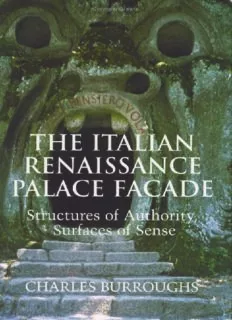
The Italian Renaissance Palace Façade: Structures of Authority, Surfaces of Sense (Res Monographs in Anthropology and Aesthetics) PDF
Preview The Italian Renaissance Palace Façade: Structures of Authority, Surfaces of Sense (Res Monographs in Anthropology and Aesthetics)
THE ITALIAN RENAISSANCE PALACE FACADE STRUCTURES OF AUTHORITY, SURFACES OF SENSE The architectural facade – a crucial and ubiquitous element of tradi- tional cityscapes – addresses and enhances the space of the city, while displaying,ordissembling,interiorarrangements.Inthisbook,Charles Burroughstrackstheemergenceofthefacadeinlate-medievalFlorence and then follows the sharply diverging reactions of Renaissance archi- tects to new demands and possibilities for representation in both resi- dential and governmental contexts. Understanding the facade as an assemblage of elements of diverse character and origin, Burroughs explores the wide range of formal solutions available to architects and patrons. In the absence of explicit reflection on the facade in Renaissance architectural discourse, Burroughs notes the theoretical implications of certain celebrated designs, implying meditation on the natureofarchitectureitselfandthesocietyitservesandrepresents,as wellasontherelationshipbetweennatureandculture.Healsoexplores theresonancebetweenshiftsinarchitecturalformandsocialspace,and theideasarticulatedintheliteraryproductionoftheperiod. CharlesBurroughsisProfessorofArtHistoryandDirectoroftheCenter forMedievalandRenaissanceStudiesatBinghamtonUniversity,SUNY. A scholar of Italian Renaissance architecture, he is the author of From SignstoDesign:EnvironmentalProcessandReforminEarlyRenaissance RomeandhaspublishedextensivelyonearlymodernItalianvisualcul- tureandurbanism,emblemsandarchitecture,andarchitecturaltheory. RES MONOGRAPHS IN ANTHROPOLOGY AND AESTHETICS series editor FrancescoPellizzi assocate editor JosephRykwert,UniversityofPennsylvania This series provides a point of encounter for contributions from diversesourcestothestudyofwhatisoftendescribedas“materialcul- ture.” Many disciplines have studied different aspects of utilitarian, decorative,andcultobjects,fromclassicaltomoderntimes,inWestern and other literate cultures. The series, with its breadth of scope and eclecticism,addressesthisrichdiversity.Likethejournalfromwhichit takes its name, it provides a forum for authors from many disciplines, including anthropology, art history, music, dance, and architectural studies. THE ITALIAN RENAISSANCE PALACE FACADE STRUCTURES OF AUTHORITY, SURFACES OF SENSE CHARLES BURROUGHS BinghamtonUniversity,SUNY CAMBRIDGE UNIVERSITY PRESS Cambridge, New York, Melbourne, Madrid, Cape Town, Singapore, São Paulo, Delhi Cambridge University Press The Edinburgh Building, Cambridge CB2 8RU, UK Published in the United States of America by Cambridge University Press, New York www.cambridge.org Information on this title: www.cambridge.org/9780521109734 © Charles Burroughs 2002 This publication is in copyright. Subject to statutory exception and to the provisions of relevant collective licensing agreements, no reproduction of any part may take place without the written permission of Cambridge University Press. First published 2002 This digitally printed version 2009 A catalogue record for this publication is available from the British Library Library of Congress Cataloguing in Publication data Burroughs, Charles. The Italian Renaissance palace facade : structures of authority, surfaces of sense / Charles Burroughs. p. cm. –(RES monographs in anthropology and aesthetics) Includes bibliographical references and index. ISBN 0 521 62438 X (hc) 1. Facades – Italy. 2. Palaces – Italy. 3. Architecture, Renaissance – Italy. 4. Symbolism in architecture – Italy. I. Title. II. Series. NA2840 .B87 2002 720´.945´09024 – dc21 2001037484 ISBN 978-0-521-62438-1 hardback ISBN 978-0-521-10973-4 paperback For Christine and Inna CONTENTS ListofIllustrations xiii Preface xvii Introduction • 1 1. TheForkedRoadtoModernity:Ambiguitiesofthe RenaissanceFacade • 12 Prelude, 12 • TheFacadeasComposition, 13 • Representationand Identity:ThePlace(s)ofHeraldry, 14 • TheFacade asScreen:BetweenTectonicsandRhetoric, 16 • TheRomanHouse: ItineraryandRepresentation, 16 • TheAgonisticFacade:FacingOff intheCourtEnclave, 17 • TriumphalArchitecture:Syntaxand Schema, 18 • FramesandMeaning, 20 • SerlioandtheLimitsof Architecture, 21 • ArchitecturalAssemblage andtheEmblematicTurn, 26 • BetweenArchitectureand Physiognomy, 29 • Vitruvius,Dearchitecto: TransparencyandProfessionalism, 30 • TheBuildingasBodyand theSubjectofArchitecture, 31 • VirtuesofTransparency; AdvantagesofOpacity, 32 • FaceandPre-Facein RenaissanceCulture, 33 • TellingStories:Antiquarianism, Ideology,andNostalgia, 35 • MemoryandMonsters:TheFacadeas Terminus,38 2. DomesticArchitectureandBoccaccianDrama:Courtand CityinFlorentineCulture • 43 BetweenOpacityandExpression, 43 • Towardthe RenaissanceCity:ShiftsinSocialSpaceandArchitectural Framing, 47 • TheFacade:MetaphoricIntersections, 48 • Body/House, 49 ix
Description: